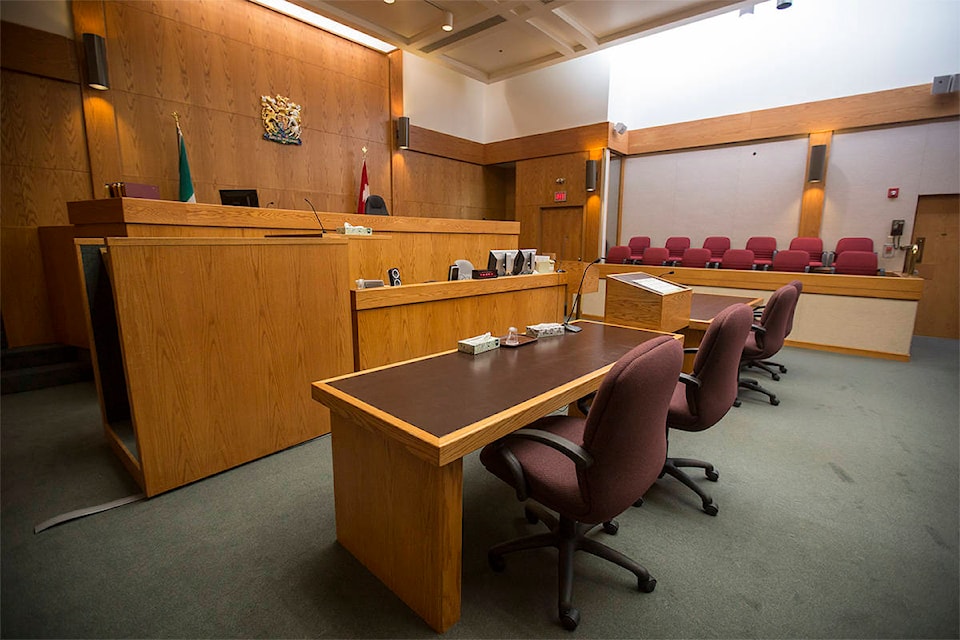The jury for Edward James Penner’s murder trial heard closing arguments Sept. 17, with the Crown arguing there was ample evidence to convict Penner while the defence described the case against him as a “house of cards.”
Penner, 22, stands charged with first-degree murder in relation to the 2017 slaying of 25-year-old Adam Cormack in Ibex Valley.
The trial began in late August, with 19 Crown witnesses testifying over two weeks.
The defence did not call any evidence.
Cormack’s body was found on a dirt trail near a gravel pit off Kilometre 1450 of the Alaska Highway on June 28, 2017. Penner was arrested two days later, initially for unrelated reasons, but was then charged with murder on July 1, 2017.
In a roughly hour-and-a-half-long address, Crown attorney Tom Lemon told the 14-person jury that when they piece all the evidence together, it should all point in one direction.
“Mr. Penner’s plan, when he and Adam walked up the trail, was to kill Adam, and he deliberately carried out that plan by putting one bullet in his head … One shot to the head, no more than necessary,” Lemon told the jury, describing it as an “execution-style killing.”
According to the Crown’s theory, laid out in pieces over the trial and summarized by Lemon, Penner travelled up to Whitehorse from British Columbia on the trail of a stolen gun. He learned Cormack was apparently responsible. On the early morning of June 28, 2017, he took Cormack out to a gravel pit area used as an unsanctioned shooting range after a party. He shot him with an AR-15.
A patchwork of witness testimony and “real evidence” — Facebook messages, fingerprints, DNA, security camera footage, scene photos and maps — should convince the jury beyond a reasonable doubt about what happened, Lemon said.
Among the evidence were two witnesses who testified Penner told them about killing Cormack; a witness who said he’d driven Penner and Cormack out to the gravel pit area, saw them walk up a trail and heard a single shot before Penner returned alone; Facebook messages that place Penner in Whitehorse beginning June 24, 2017; and multiple photos of Penner posing with an AR-15.
“Such a weapon only has one purpose, and the purpose is to kill humans,” Lemon said.
The alleged murder weapon was never recovered.
There were also Pepsi cans found down the trail from Cormack’s body with Penner and Cormack’s fingerprints and DNA on them, Lemon said, and although a bullet recovered at the scene was not conclusively found to have DNA on it, the jury must remember it was found embedded in the dirt near Cormack’s body.
While some of the witnesses were not “textbook,” Lemon acknowledged, in the end, they all still told the truth. Their testimonies corroborated key details of each other’s stories or were backed up by the “real evidence,” Lemon said, and to assume everything was just coincidence stretched reason.
Defence lawyer Andre Ouellette tore into the Crown’s case in a statement loaded with figures of speech.
“How many pigs’ ears to make a silk purse? How many lies does it take until it adds up to the truth? If you say something often enough, does it become true?” he asked.
The Crown, he said, had assembled a “house of cards… And they want to sell you the real estate.”
Ouellette said there was “no question” that Penner had come up to Whitehorse to deal drugs based on the Facebook messages, but there’s no evidence of him travelling north for anything else. No other witnesses, he pointed out, backed up witness Alain Bernier’s assertion that Penner told him he was investigating a missing gun and looking for Cormack.
The Crown also left a number of questions unanswered, Ouellette said, suggesting that those holes were inviting jurors to speculate instead of relying on facts. There was no evidence on how or when Penner obtained the AR-15, for example, or when Penner actually took the photos of himself with the gun — it could have been weeks or months before he shared them on Facebook.
As well, it was never established when Penner’s DNA or fingerprints were deposited on the Pepsi can, and the AR-15, along with the bullet the Crown alleges killed Cormack, are commonly available throughout Canada. It can’t even be said with certainty that it was an AR-15 that killed Cormack, Ouellette said — the forensic pathologist on the case testified that a high-powered handgun could also have been used.
“The totality is misleading here because it’s made up of parts that don’t add up,” he said.
Ouellette also attacked the credibility of the witnesses who weren’t professionally involved in the case, describing them as “compromised.” Many were heavy drug users at the time, he noted, and had personal or social circumstances that could have incentivized them to pin the blame for the murder on an outsider instead of one of their own.
Speculation and assumptions aren’t good enough, he reminded the jury Ouellette.
“Would you bet your life on the evidence you heard here?” he asked. “Would you bet someone else’s?”
Justice Scott Brooker is expected to deliver his charge to the jury the morning of Sept. 18. Twelve jurors will then be sequestered for deliberations.
Contact Jackie Hong at jackie.hong@yukon-news.com
